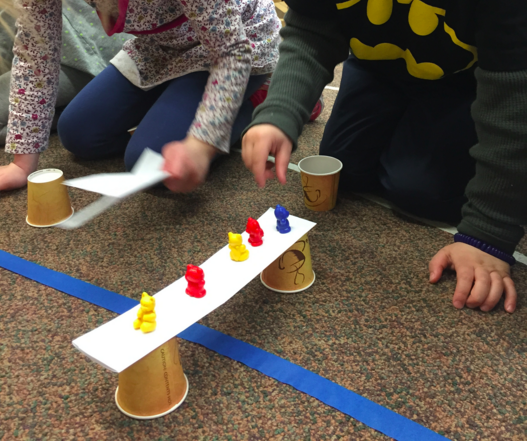Using Play to Build STEM Skills


You may have noticed the current buzz surrounding STEM (science, technology, engineering and mathematics) education. Not only do skills in these fields boost innovative thinking and creative problem solving, but experts say that STEM education is key to the economic future of the United States.
While experience with computers and robotics can be invaluable, STEM skills can also be boosted at home during the normal course of play. No batteries required!
MIND YOUR LANGUAGE
How: Almost every time we play with our little ones there is an opportunity to discuss spatial concepts. Whether you’re playing with play dough, dolls or cars, be sure to discuss where the toys are located in relation to each other, as well as their sizes, quantities and shapes.
Why: Even the youngest of children can begin to develop math skills. Research shows that when children under 3 years of age are exposed to spatial language (shape, size, location), they are more likely to use spatial vocabulary themselves as their verbal skills develop. These children then grow to have a better understanding of related math concepts as a result.
BUILD, BUILD, BUILD
How: Unstructured play with blocks has been linked to improved math ability. Dump a box of blocks on the floor as a simple invitation to play for your future engineer.
Why: Studies indicate that spatial thinking may be increased by playing with blocks and other constructive materials. Blocks give kids the opportunity to manipulate objects in space and mentally rotate or move them. There’s also lots of room to practice divergent problem solving. As children investigate questions like, “Will this block fit here?” they are developing spatial awareness or a sense of the relationship between objects and the environment.
RAID THE KITCHEN
How: Everyday items found in the kitchen can be used to create simple experiments that provide a perfect introduction to chemistry. Mix 2 parts cornstarch with 1 part water to create “magic mud,” a remarkable substance that can lead the basis for a discussion of liquids and solids. For older children it’s an opportunity to discuss colloids and non-Newtonian fluids. Either way, encourage your child to get their hands in the mud, roll it into balls and let it drip from their fingers. It’s a wonderfully fun sensory experience!
Why: Not only does learning about chemistry help us understand the world around us, it also provides great opportunity to practice reasoning and problem solving skills.

BRIDGING THE GAP
How: Gather household materials and practice making candy bridges. Show your child how to connect gum drops or marshmallows with toothpicks and experiment to see which designs create the sturdiest structures. Encourage your kiddo to test the strength of their creations by lining the bridge with paper or popsicle sticks and marching small figurines across.
Why: When kids use engineering skills, they’re able to apply math and science lessons in a hands-on way. Not only does this help strengthen their skills, but also allows them to see how these fields can solve real life problems.
Whether your goal is to enhance your child’s STEM education, or simply to have fun, these playful activities are great for cognitive development and imagination. Have fun and follow your child’s interests for best results!
Main Photo by Julian Barlow
Recent Articles
-
Playful Primer 10 Must-Have Toys for Your Next Backyard BBQ
Summer is just around the corner and we're ready for it! From backyard BBQs to neighborhood park outings, we've discovered...
read more -
Playful Primer Tips & Toys to Support Group Play Experiences
Catching a glimpse of children happily engaged in pretend play is like witnessing pure magic. Ever wonder how closely you...
read more -
Playful Primer 5 Ways to Strengthen the Bond Between Siblings
“I’ll take care of the bike. You take care of each other.” This is what I said to my children...
read more

